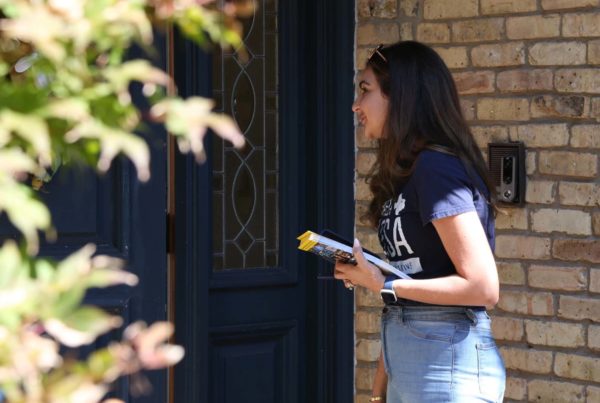Leading up to the 2022 midterm elections, there were a number of stories Texans were watching.
There are of course the headline stories, like Beto O’Rourke’s loss, but there were also a number of down ballot races that reveal a lot about the Republican Party’s attempt to pull off a “red wave.”
» TEXAS ELECTION 2022: See election results for statewide and congressional races
Elizabeth Simas, Associate Professor of Political Science at the University of Houston and Sergio Martínez-Beltrán, reporter for the Texas Newsroom, joined the Texas Standard to give their analysis of how the midterms went in Texas. Listen to the story above or read the transcript below.
This transcript has been edited lightly for clarity:
Texas Standard: Incumbent Governor Greg Abbott beat Democratic challenger Beto O’Rourke by nearly a million votes, a much larger margin than Democrats were hoping for or that polling showed. Sergio, how do you see the results from the top of the ticket in Texas?
Sergio Martínez-Beltrán: I think the unofficial results that we’re seeing honestly are not surprising. Every Republican on the top of the ticket – Governor Abbott, Lieutenant Governor Dan Patrick, Attorney General Ken Paxton and others comfortably won their races. And I think this shows that the majority of Texans are either in support or at least okay with the policy proposals of the Republican majority in the state. And I think a big part of Abbott’s victory was his messaging throughout his campaign. He focused on immigration, the state economy, inflation. Those are issues he governor’s campaign this morning told reporters resonated more with more voters than the issues that O’Rourke was focusing on, like access to reproductive health and gun control.
Professor Simas, we saw Republicans holding on to the other statewide contests – lieutenant governor and attorney general. Incumbent Republican Ken Paxton, who has frequently been in the news for legal troubles, beat Democrat Rochelle Garza by around ten percentage points. Now, professor, what do you make of that result?
Elizabeth Simas: I think that, again, echoing what we said earlier, just a reflection of the fact that we’re just seeing more of the status quo in Texas. Which on one hand is sending signals that, yes, there’s still a Republican majority here and that people are satisfied with the way things are going. But “status quo” looking the same – that a lot of these election returns looked as they did in 2018 – that’s not what the Republicans were expecting. I think especially given that we had Biden as the president, we know that the president’s party typically does not do so well in these midterm elections. And so the fact that the Democrats did stay the course and that we saw, you know, pretty much the same numbers coming in across Texas that we did in 2018, that’s actually saying a lot, despite the fact that it’s not different.
» READ MORE: Texas GOP continues statewide election sweep as Abbott, Patrick and Paxton win reelection
Professor Simas, let’s pull back a little bit and look at Democratic versus Republican messaging for statewide office. Lots of issues we’ve talked about here: the economy, immigration, abortion. What seemed to resonate with voters?
Simas: You know, I think the abortion issue did not take hold as much as the O’Rourke campaign or Democrats thought that it perhaps would at the start of the campaign. I really think it did come down to the economy. But you know that, along with security, are going to be big things. But those things mean different things to different people. So it’s going to be interesting going forward, I think.
Well, Sergio – lots of talk in the lead up to yesterday’s midterms about a “red wave” both nationally and in Texas. So Texas has long been red. Did we see a red wave here?
Martínez-Beltrán: We did not. Like you mentioned, Texas has long been red. So I think we also have to ask the question, what would a red wave have looked like in Texas? And I think maybe it was flipping the three congressional districts in the Rio Grande Valley. We know that didn’t work for Republicans, despite them spending a lot of money and investing heavily in the area. You know, most of the border counties also went forward showing that those counties are still blue and are still Democrats. So I think that the narrative of the red wave is not true at this point.
Well, last night after losing her race, Republican Congresswoman Mayra Flores tweeted out, quote, “The red wave did not happen. Republicans and independents stayed home. DO NOT COMPLAIN ABOUT THE RESULTS IF YOU DID NOT DO YOUR PART!” So, Professor Simas, what do you make of that? Republicans get the results they wanted in Texas? And if not, was turnout an issue?
Simas: My guess would be that turnout is what it came down to. I mean, we’re certainly not going to see too many people flipping parties. And so both parties needed a lot of voters out there and I think both maybe fell short of their goal. But, yes, if we didn’t get the numbers out there that the Republicans want, that certainly is what we’re seeing in these results so far.
Well, let’s talk now a little bit about Democrats. Obviously, O’Rourke’s loss is what most people will remember. But Democrats also struggle to mount a serious challenge to other down ballot races like lieutenant governor or attorney general. Sergio, is this what Democrats expected or is this, quote, a “bad performance” for them?
Martínez-Beltrán: That’s a great question. I think Democrats were hopeful about making gains. But I think realistically, they knew getting there was going to be very challenging. You know, I bet they are disappointed. I think the results of last night showed that it is very hard for Democrats at this point to win statewide office, like you mentioned. Besides the governor’s race, Democrats really placed a lot of their efforts in electing Rochelle Garza, their candidate for AG. Many said she was the Democrats best chance to win statewide office. She was running against Attorney General Ken Paxton. We’ve talked about him. He’s a very controversial figure under indictment, the State has accused him of misconduct and he’s been involved in overturning the 2020 presidential election results. So he was an embattled candidate and yet Democrats were not able to get him out of office this time.
Well, Sergio, sticking with you, were there any interesting developments from the Texas legislature races?
Martínez-Beltrán: Not really. I think bottom line, Republicans are still in control and that’s something that we’re seeing. And I think what’s going to be interesting, is what’s going to be their priorities next year, the next session that starts in January. You know what are going to be those priorities that they’re going to push now that they, again, continue with control?
Well, Professor Simas, do the election results so far reveal anything surprising about Texas voters?
Simas: I think it just really shows the deep partisan divide. Even though you were talking about how the Democrats didn’t necessarily have the high profile candidates that they wanted for those other statewide offices. If you look, there wasn’t a tremendous amount of roll off from people, going and voting for better and then not voting for Democrats further down the ticket. We saw pretty much the same or what I’m seeing so far look pretty similar roll off on both sides, which is showing you, I think that it’s somewhat less about the candidate, but really about party. And Texans are becoming really, you know, divided by party. And so I agree that I think the priorities of the legislature put forward in the next session are going to be very important for setting up the races going forward, because there is this polarization. And if they’re picking up on the issues that really are pushing buttons on one side or the other, we’re going to see some interesting races going forward.
For both of you, how does Texas fit into the big picture when you look at the midterms?
Martínez-Beltrán: Well, like Professor Simas mentioned earlier, Democrats were able to hold their line in a way. And we’re seeing it in the congressional districts and also in some of the counties. But I think what shows here is that, again, the narrative of the “red wave” was not completed. To me, Republicans were not able to be successful in actually doing this whole flip across the board.
Simas: Yeah. I think Texas looks a lot like the rest of the country. There wasn’t necessarily this big change. Again, the last I looked, you know, probably going to come down to Georgia with the Senate, the House, maybe. But the margin there is going to be a lot smaller than I think a lot of people were expecting. There were a lot of Democrats that were able to hold on to a seat. And so it just wasn’t the real slam on Biden that I think people were expecting.















